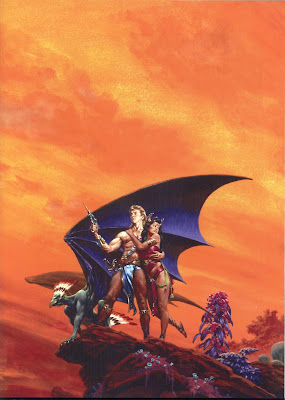The Art of Richard Hescox
text by Randy M. Dannenfelser
Paper Tiger, 2004
Starting in 1974, with his first commercial art illustration - the cover of issue 7 of Monsters Unleashed (Marvel / Curtis) - Hescox would go on to be one of the foremost artists for paperback and hardback covers.
'The Deceiving Eye' is an overview of Hescox's work from 1974 to the early 2000s. The opening chapters cover Hescox's education and early career work, which saw him grow up in Pasadena, California, and attend the Art Center College of Design in Hollywood. As a student, Hescox earned money by painting portraits for people visiting Disneyland in Anaheim. Upon graduation from the Art Center, he worked at the Los Angeles Museum of Natural History.
Seeking to break into the world of commercial art, and science fiction illustration in particular, Hescox entered his portfolio into the art show held at the 1973 San Diego Comic Con. Neal Adams, who also was in attendance, asked for a private showing of the entries, after which he asked to see Hescox. As a result, Adams volunteered to send Hescox's work to Marvel for their consideration, which launched Hescox's career as an illustrator.
In 1975 Hescox broke into the book cover market when he received commissions from DAW Books. The quality of his artwork soon earned him a steady stream of assignments for book cover art for other publishers, such as Del Rey, Signet, and Ace Books, throughout the 80s and early 90s.
During this time Hescox also took commissions for film production and advertising.
'The Deceiving Eye' features a chapter on Hescox's studio artwork, which - with its portraits of nubile young women posing in exotic landscapes - is inspired by the art of 19th Century British artists like John William Waterhouse, Lawrence Alma-Tadema, Herbert James Draper.
Other chapters focus on the artist's experiences earning a living as a commercial artist; there are some wry observations here about the nature of such work. One chapter is titled Never Assume the Art Director Has Read the Book, which deals with Hescox's interactions with a confused art director at Ace Books.
In 1992, after becoming increasingly dissatisfied with his interactions with art directors at the publishing houses, Hescox decided to make a major career change and seek employment in the burgeoning computer gaming realm. This led to jobs creating concept sketches and renderings for a number of sf and fantasy games such as Microsoft's Mechwarrior and Sierra's Earth Siege.




















































































